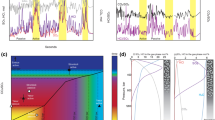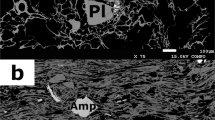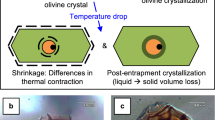Abstract
Super-eruptions that dwarf all historical volcanic episodes in erupted volume1 and environmental impact2 are abundant in the geological record. Such eruptions of silica-rich magmas form large calderas. The mechanisms that trigger these super-eruptions are elusive because the processes occurring in conventional volcanic systems cannot simply be scaled up to the much larger magma chambers beneath supervolcanoes. Over-pressurization of the magma reservoir, caused by magma recharge, is a common trigger for smaller eruptions3, but is insufficient to generate eruptions from large supervolcano magma chambers4. Magma buoyancy can potentially create sufficient overpressure4, but the efficiency of this trigger mechanism has not been tested. Here we use synchrotron measurements of X-ray absorption5 to determine the density of silica-rich magmas at pressures and temperatures of up to 3.6 GPa and 1,950 K, respectively. We combine our results with existing measurements of silica-rich magma density at ambient pressures6,7 to show that magma buoyancy can generate an overpressure on the roof of a large supervolcano magma chamber that exceeds the critical overpressure of 10–40 MPa required to induce dyke propagation4, even when the magma is undersaturated in volatiles. We conclude that magma buoyancy alone is a viable mechanism to trigger a super-eruption, although magma recharge and mush rejuvenation8, volatile saturation9 or tectonic stress10 may have been important during specific eruptions.
This is a preview of subscription content, access via your institution
Access options
Subscribe to this journal
Receive 12 print issues and online access
$259.00 per year
only $21.58 per issue
Buy this article
- Purchase on Springer Link
- Instant access to full article PDF
Prices may be subject to local taxes which are calculated during checkout



Similar content being viewed by others
References
Mason, B. G., Pyle, D. M. & Oppenheimer, C. The size and frequency of the largest explosive eruptions on Earth. Bull. Volcanol. 66, 735–748 (2004).
Self, S. & Blake, S. Consequences of explosive supereruptions. Elements 4, 41–46 (2008).
Sparks, S. R. J. & Sigurdsson, H. Magma mixing: A mechanism for triggering acid explosive eruptions. Nature 267, 315–318 (1977).
Jellinek, A. M. & DePaolo, D. J. A model for the origin of large silicic magma chambers: Precursors of caldera-forming eruptions. Bull. Volcanol. 65, 363–381 (2003).
Sakamaki, T., Ohtani, E., Urakawa, S. & Suzuki, A. Measurements of hydrous peridotite magma density at high pressure using the X-ray absorption method. Earth Planet. Sci. Lett. 287, 293–297 (2009).
Knoche, R., Webb, S. L. & Dingwell, D. B. A partial molar volume for B2O3 in haplogranitic melt. Canad. Mineral. 30, 561–569 (1992).
Ochs, F. A. & Lange, R. A. The density of hydrous magmatic liquids. Science 283, 1314–1317 (1999).
Bachmann, O. & Bergantz, G. W. The magma reservoirs that feed supereruptions. Elements 4, 17–21 (2008).
Blake, S. Volatile oversaturation during the evolution of silicic magma chambers as an eruption trigger. J. Geophys. Res. 89, 8237–8244 (1984).
Allan, A. S. R., Wilson, C. J. N., Millet, M-A. & Wysoczanski, R. J. The invisible hand: Tectonic triggering and modulation of a rhyolitic supereruption. Geology 40, 563–566 (2012).
Hansen, J., Ruedy, R. & Sato, M. Global surface air temperature in 1995: Return to pre-Pinatubo level. Geophys. Res. Lett. 23, 1665–1668 (1996).
Jones, G. S., Gregory, J. M., Stott, P. A., Tett, S. F. B. & Thorpe, R. B. An AOGCM simulation of the climate response to a volcanic super-eruption. Clim. Dynam. 25, 725–738 (2005).
Gregg, P. M., de Silva, S. L., Grosfils, E. B. & Parmigiani, J. P. Catastrophic caldera-forming eruptions: Thermomechanics and implications for eruption triggering and maximum caldera dimensions on Earth. J. Volcanol. Geotherm. Res. 241–242, 1–12 (2012).
Agee, C. B. Static compression of hydrous silicate melt and the effect of water on planetary differentiation. Earth Planet. Sci. Lett. 265, 641–654 (2008).
Matsukage, K. N., Jing, Z. & Karato, S. I. Density of hydrous silicate melt at the conditions of Earth’s deep upper mantle. Nature 438, 488–491 (2005).
Sakamaki, T., Suzuki, A. & Ohtani, E. Stability of hydrous melt at the base of the Earth’s upper mantle. Nature 439, 192–194 (2006).
Rivers, M. L. & Carmichael, I. S. E. Ultrasound studies of silicate melts. J. Geophys. Res. 92, 9247–9270 (1987).
Mezouar, M. in High-Pressure Crystallography: From Fundamental Phenomena to Technological Applications (eds Boldyreva, E. & Dera, P.) 23–33 (Springer, 2010).
Lange, R. A. & Carmichael, I. S. E. Densities of Na2O–K2O–CaO–MgO–FeO–Fe2O3–Al2O3–TiO2–SiO2 liquids: New measurements and derived partial molar properties. Geochim. Cosmochim. Acta 51, 2931–2946 (1987).
Agee, C. B. Compressibility of water in magma and the prediction of density crossovers in mantle differentiation. Phil. Trans. R. Soc. A 366, 4239–4252 (2008).
Burnham, C. W. & Davis, N. F. Role of H2O in silicate melts. 1. P–V–T relations in the system NaAlSi3O8–H2O to 10 kilobars and 1000 °C. Am. J. Sci. 270, 54–79 (1971).
Mookherjee, M., Stixrude, L. & Karki, B. Hydrous silicate melt at high pressure. Nature 452, 983–986 (2008).
Pitzer, K. S. & Sterner, S. M. Equations of state valid continuously from zero to extreme pressures for H2O and CO2 . J. Chem. Phys. 101, 3111–3116 (1994).
Malfait, W.J., Sanchez-Valle, C., Ardia, P., Médard, E. & Lerch, P. Compositional dependent compressibility of dissolved water in silicate glasses. Am. Mineral. 96, 1402–1409 (2011).
Whitney, J. A. & Stormer, J. C. Mineralogy, Petrology, and magmatic conditions from the Fish Canyon Tuff, Central San Juan Volcanic Field, Colorado. J. Petrol. 26, 726–762 (1985).
Bachmann, O. & Bergantz, G. W. On the origin of crystal-poor rhyolites: Extracted from batholitic crystal mushes. J. Petrol. 45, 1565–1582 (2004).
Wallace, P. J., Andersen, A. T. & Davis, A. M. Quantification of pre-eruptive exsolved gas contents in silicic magmas. Nature 337, 612–616 (1995).
Miller, D. S. & Smith, R. B. P and S velocity structure of the Yellowstone volcanic field from local earthquake and controlled-source tomography. J. Geophys. Res. 104, 15105–15121 (1999).
Chu, R., Helmberger, D. V., Sun, D., Jackson, J. M. & Zhu, L. Mushy magma beneath Yellowstone. Geophys. Res. Lett. 37, L01306 (2010).
Bachmann, O. & Bergantz, G.W. Rejuvenation of the Fish Canyon magma body: A window in the evolution of large-volume silicic magma systems. Geology 31, 789–792 (2003).
Acknowledgements
We thank the ESRF for provision of the beam-time for these experiments and the SLS for the access to the IR facilities for the water analysis. We thank C. Yao for her help during data collection at the synchrotron and P. Ardia for providing the HGG0 and HGG5 sample. This research was supported by the Swiss National Science Foundation through grant 200021_130123 to C.S-V.
Author information
Authors and Affiliations
Contributions
W.J.M. and C.S-V. designed the study and W.J.M., R.S., C.S-V., S.P., J-P.P. and M.M. conducted the synchrotron experiments. W.J.M. and P.L. carried out the FTIR measurements and T.O. and E.N. provided the SIMS data. W.J.M. prepared the starting materials, conducted the electron microprobe analysis and carried out the data treatment and overpressure modelling. W.J.M and C.S-V. wrote the manuscript and all other authors commented on the manuscript.
Corresponding authors
Ethics declarations
Competing interests
The authors declare no competing financial interests.
Supplementary information
Supplementary Information
Supplementary Information (PDF 1923 kb)
Rights and permissions
About this article
Cite this article
Malfait, W., Seifert, R., Petitgirard, S. et al. Supervolcano eruptions driven by melt buoyancy in large silicic magma chambers. Nature Geosci 7, 122–125 (2014). https://doi.org/10.1038/ngeo2042
Received:
Accepted:
Published:
Issue Date:
DOI: https://doi.org/10.1038/ngeo2042
This article is cited by
-
Ultra-crystalline pyroclastic deposits and rhyolitic lavas controlled by crystal mushes: insights from the Acoculco Caldera Complex, México
Contributions to Mineralogy and Petrology (2023)
-
On the rise: using reentrants to extract magma ascent rates in the Bandelier Tuff caldera complex, New Mexico, USA
Bulletin of Volcanology (2022)
-
Eruptive history of Mason Spur, a Miocene—Pleistocene polygenetic volcanic complex in southern Victoria Land, West Antarctic Rift System, Antarctica
Bulletin of Volcanology (2022)
-
Behavior and properties of water in silicate melts under deep mantle conditions
Scientific Reports (2021)
-
The build-up and triggers of volcanic eruptions
Nature Reviews Earth & Environment (2021)



